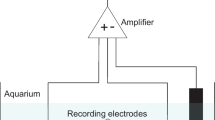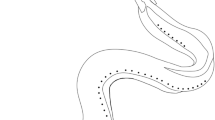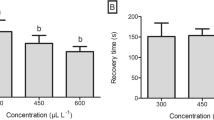Abstract
Anesthesia is used to sedate aquatic animals during transportation or to immobilize them for surgery. However, most studies have focused on the behavioral effects of induction and recovery, without addressing the effect of anesthetic on neural activity. This study investigated the neural response of anterior lateral line afferent fibers in the oyster toadfish, Opsanus tau, during exposure to incremental increases of AQUI-S 20E (0.001–0.006%), to determine if eugenol (the active ingredient of AQUI-S 20E) influences neural activity of the fish lateral line system. Ventilation rate significantly decreased following AQUI-S 20E exposure with the surgical plane of anesthesia reached at 0.003%, characterized by shallow ventilation, equilibrium loss, and no response to tactile stimuli. Spontaneous and evoked firing rates of anterior lateral line fibers also significantly decreased following exposure, although the effect was transitory as neural activity recovered in the majority of fibers (70%) within 30 min of anesthetic withdrawal. While AQUI-S 20E proved effective in inducing the surgical plane of anesthesia without compromising survival, it is not recommended for acute neural preparations due to its depression of neural activity. However, the depression of lateral line sensitivity at low concentrations could play a role in reducing the stress response during fish transport.






Similar content being viewed by others
References
AQUI-S Ltd (2019) Study protocol for a compassionate aquaculture investigational new animal drug (INAD) exemption for AQUI-S®20E (eugenol)(INAD #11–741). U.S. Fish and Wildlife Service, Division of Fish Hatcheries
Armstrong R, Riaz S, Hasan S, Iqbal F, Rice T, Syed N (2018) Mechanisms of anesthetic action and neurotoxicity: lessons from molluscs. Front Physiol 8
Bolasina SN, de Azevedo A, Petry AC (2017) Comparative efficacy of benzocaine, tricaine methanesulfonate and eugenol as anesthetic agents in the guppy Poecilia vivipara. Aquac Rep 6:56–60
Carter KM, Woodley CM, Brown RS (2011) A review of tricaine methanesulfonate for anesthesia of fish. Rev Fish Biol Fish 21:51–59
Cho GK, Heath DD (2000) Comparison of tricaine methanesulphonate (MS222) and clove oil anaesthesia effects on the physiology of juvenile chinook salmon Oncorhynchus tshawytscha (Walbaum). Aquac Res 31:537–546
de Oliveira CPB, Lemos CHDP, Felix e Silva A, de Souza SA, Albinati ACL, Lima AO, Copatti CE (2019) Use of eugenol for the anaesthesia and transportation of freshwater angelfish (Pterophyllum scalare). Aquaculture 513:734409
Engelmann J, Hanke W, Bleckmann H (2002) Lateral line reception in still- and running water. J Comp Physiol A 188:513–526
Garcia PS, Kolesky SE, Jenkins A (2010) General anesthetic actions on GABA(A) receptors. Curr Neuropharmacol 8:2–9
Goldberg JM, Brown PB (1969) Response of binaural neurons of dog superior olivary complex to dichotic tonal stimuli: some physiological mechanisms of sound localization. J Neurophysiol 32:613–636
Hensel H, Bromm B, Nier K (1975) Effect of ethyl m-aminobenzoate (MS-222) on ampullae of lorenzini and lateral-line organs. Experientia 31:958–960
Jacobsen JV, Steen K, Nilssen KJ (2019) Anaesthetic efficacy of Aqui-S, Benzoak, and MS-222 on lumpfish (Cyclopterus lumpus) fries. Impact from temperature, salinity, and fasting. PLOS ONE 14:e0211080
Javahery S, Nekoubin H, Moradlu AH (2012) Effect of anaesthesia with clove oil in fish (review). Fish Physiol Biochem 38:1545–1552
King VW, Hooper B, Hillsgrove S, Benton C, Berlinsky DL (2005) The use of clove oil, metomidate, tricaine methanesulphonate and 2-phenoxyethanol for inducing anaesthesia and their effect on the cortisol stress response in black sea bass (Centropristis striata L.). Aquac Res 36:1442–1449
Köppl C (1997) Phase locking to high frequencies in the auditory nerve and cochlear nucleus magnocellularis of the barn owl, Tyto alba. J Neurosci 17:3312–3321
Levitan IB, Kaczmarek LK (2015) The neuron: cell and molecular biology. Oxford University Press
Lu Z, Fay RR (1993) Acoustic response properties of single units in the torus semicircularis of the goldfish, Carassius auratus. J Comp Physiol A 173:33–48
Mensinger AF, Van Wert JC, Rogers LS (2019) Lateral line sensitivity in free-swimming toadfish (Opsanus tau). J Exp Biol 222:jeb190587
Montgomery JC, Coombs S (1998) Peripheral encoding of moving sources by the lateral line system of a sit-and-wait predator. J Exp Biol 201:91
Palmer LM, Mensinger AF (2004) Effect of the anesthetic tricaine (MS-222) on nerve activity in the anterior lateral line of the oyster toadfish, Opsanus tau. J Neurophysiol 92:1034–1041
Palmer LM, Deffenbaugh M, Mensinger AF (2005) Sensitivity of the anterior lateral line to natural stimuli in the oyster toadfish, Opsanus tau (Linnaeus). J Exp Biol 208:3441–3450
Priborsky J, Velisek J (2018) A review of three commonly used fish anesthetics. Rev Fish Sci Aquac 26:417–442
Rogers LS, Van Wert JC, Mensinger AF (2017) An implantable two axis micromanipulator made with a 3D printer for recording neural activity in free-swimming fish. J Neurosci Methods 288:29–33
Roubach R, Gomes LC, Leão Fonseca FA, Val AL (2005) Eugenol as an efficacious anaesthetic for tambaqui, Colossoma macropomum (Cuvier). Aquac Res 36:1056–1061
Schaus MJ, Moehlis J (2006) On the response of neurons to sinusoidal current stimuli: phase response curves and phase-locking. In: Proceedings of the 45th IEEE Conference on Decision and Control, pp 2376-2381
Sladky K, Swanson CR, Stoskopf MK, Loomis MR, Lewbart GA (2001) Comparative efficacy of tricaine methanosulfonate and clove oil for use as anesthetics in red pacu (Piaractus brachypomus). Am J Vet Res 62:337–342
Späth M, Schweickert W (1977) The effect of metacaine (MS-222) on the activity of the efferent and afferent nerves in the teleost lateral-line system. Naunyn Schmiedeberg’s Arch Pharmacol 297:9–16
Summerfelt RS, Smith LS (1990) Anesthesia, surgery, and related techniques. In: Schreck CB, Boyle PB (eds) Methods for fish biology. American Fisheries Society, Bethesda, pp 213–272
Topic-Popovic N, Strunjak-Perovic I, Coz-Rakovac R, Barisic J, Jadan M, Persin Berakovic A, Sauerborn Klobucar R (2012) Tricaine methane-sulfonate (MS-222) application in fish anaesthesia. J Appl Ichthyol 28:553–564
Tricas TC, Highstein SM (1991) Action of the octavolateralis efferent system upon the lateral line of free-swimming toadfish, Opsanus tau. J Comp Physiol A 169:25–37
Weyl O, Kaiser H, Hecht T (1996) On the efficacy and mode of action of 2-phenoxyethanol as an anaesthetic for goldfish, Carassius auratus (L.), at different temperatures and concentrations. Aquac Res 27:757–764
Zahl IH, Samuelsen O, Kiessling A (2012) Anaesthesia of farmed fish: implications for welfare. Fish Physiol Biochem 38:201–218
Acknowledgments
The authors would like to acknowledge the Marine Resources Center staff at the Marine Biological Laboratory for providing toadfish care. We would also like to thank Lisa Abbo for veterinary advice on the project, and the Aquatic Animal Drug Approval Partnership Program (AADAP) and Bonnie Johnson at the (INAD) for overseeing animal care protocols when using AQUI-S 20E. The project was conducted under study #11-741-19-256.
Funding
Funding was provided by the Mistletoe Postdoctoral Fellowship to RLP, the National Science Foundation Graduate Research Fellowship Program under grant DGE 1762114 to LSR, and the National Science Foundation Grant IOS 1354745 to AFM.
Author information
Authors and Affiliations
Contributions
RLP, LSR, BG, and AFM: conception and design of research; RLP, LSR, and BG: performed experiments; RLP: analyzed data; RLP and LSR: interpreted results; RLP: prepared figures and drafted manuscript; RLP: wrote the first draft; LSR, BG, and AFM: edited, revised, and approved final version of the manuscript.
Corresponding author
Ethics declarations
Conflict of interest
The authors declare no that they have no competing interests.
Data availability
All data for this study will be made available to the public in the Dryad repository following publication.
Code availability
Not applicable.
Additional information
Publisher’s note
Springer Nature remains neutral with regard to jurisdictional claims in published maps and institutional affiliations.
Electronic supplementary material
ESM 1
(DOCX 1110 kb)
Rights and permissions
About this article
Cite this article
Putland, R., Rogers, L., Giuffrida, B. et al. Anesthetic effects of AQUI-S 20E® (eugenol) on the afferent neural activity of the oyster toadfish (Opsanus tau). Fish Physiol Biochem 46, 2213–2226 (2020). https://doi.org/10.1007/s10695-020-00874-w
Received:
Accepted:
Published:
Issue Date:
DOI: https://doi.org/10.1007/s10695-020-00874-w




